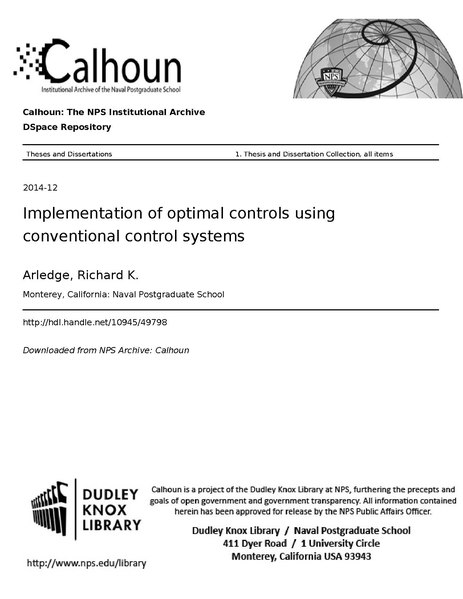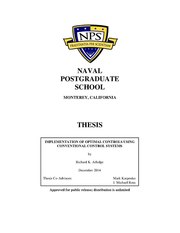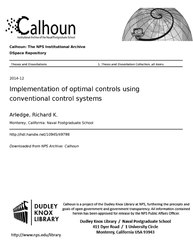File:Implementation of optimal controls using conventional control systems (IA implementationof1094549798).pdf

Original file (1,275 × 1,650 pixels, file size: 2.06 MB, MIME type: application/pdf, 100 pages)
Captions
Captions
Summary[edit]
| Implementation of optimal controls using conventional control systems
( |
||
|---|---|---|
| Author |
Arledge, Richard K. |
|
| Title |
Implementation of optimal controls using conventional control systems |
|
| Publisher |
Monterey, California: Naval Postgraduate School |
|
| Description |
This thesis investigates the implementation of optimal control solutions for positioning spacecraft antenna using conventional techniques. Conventional maneuvers consider each axis independently and may include artificial limits that reduce the efficiency of the system. These methods allow simple, but generally suboptimal, maneuver design. Multi-body dynamic systems do, however, exhibit coupling effects that can be advantageous for enhancing motion planning. Including coupling effects in the model can reduce energy needed to implement a slew maneuver. For example, previous work demonstrated that optimal control solutions can reduce required slew time for spacecraft antenna maneuvers. This work explores the utility of implementing such optimal trajectories as reference maneuvers using current control schemes. Development and validation of the approach is explored using systems of increasing dynamic complexity. Two methods to match given optimal control profiles using existing control logic were developed and compared against current practice. The developed methods were applied to the results for a double gimbal model and the Tracking Data Relay Satellite. The developed approach allows optimal trajectories to be successfully matched to within 2% position error along the trajectory using less than four conventional maneuvers. These results thus provide a simplified approach for implanting optimal slew maneuvers. Subjects: Optimal Slew Maneuvers; Spacecraft; Antenna; Communications Satellite; Multi-body Dynamics; Dynamic Coupling; Optimal Control; Double Gimbal |
|
| Language | English | |
| Publication date | December 2014 | |
| Current location |
IA Collections: navalpostgraduateschoollibrary; fedlink |
|
| Accession number |
implementationof1094549798 |
|
| Source | ||
| Permission (Reusing this file) |
This publication is a work of the U.S. Government as defined in Title 17, United States Code, Section 101. Copyright protection is not available for this work in the United States. | |
Licensing[edit]
| Public domainPublic domainfalsefalse |
This work is in the public domain in the United States because it is a work prepared by an officer or employee of the United States Government as part of that person’s official duties under the terms of Title 17, Chapter 1, Section 105 of the US Code.
Note: This only applies to original works of the Federal Government and not to the work of any individual U.S. state, territory, commonwealth, county, municipality, or any other subdivision. This template also does not apply to postage stamp designs published by the United States Postal Service since 1978. (See § 313.6(C)(1) of Compendium of U.S. Copyright Office Practices). It also does not apply to certain US coins; see The US Mint Terms of Use.
|
 | |
| This file has been identified as being free of known restrictions under copyright law, including all related and neighboring rights. | ||
https://creativecommons.org/publicdomain/mark/1.0/PDMCreative Commons Public Domain Mark 1.0falsefalse
File history
Click on a date/time to view the file as it appeared at that time.
| Date/Time | Thumbnail | Dimensions | User | Comment | |
|---|---|---|---|---|---|
| current | 23:11, 21 July 2020 |  | 1,275 × 1,650, 100 pages (2.06 MB) | Fæ (talk | contribs) | FEDLINK - United States Federal Collection implementationof1094549798 (User talk:Fæ/IA books#Fork8) (batch 1993-2020 #18356) |
You cannot overwrite this file.
File usage on Commons
The following page uses this file:
Metadata
This file contains additional information such as Exif metadata which may have been added by the digital camera, scanner, or software program used to create or digitize it. If the file has been modified from its original state, some details such as the timestamp may not fully reflect those of the original file. The timestamp is only as accurate as the clock in the camera, and it may be completely wrong.
| Short title | Implementation of optimal controls using conventional control systems |
|---|---|
| Author | Arledge, Richard K. |
| Software used | Arledge, Richard K. |
| Conversion program | Microsoft® Word 2010 |
| Encrypted | no |
| Page size | 612 x 792 pts (letter) |
| Version of PDF format | 1.4 |

